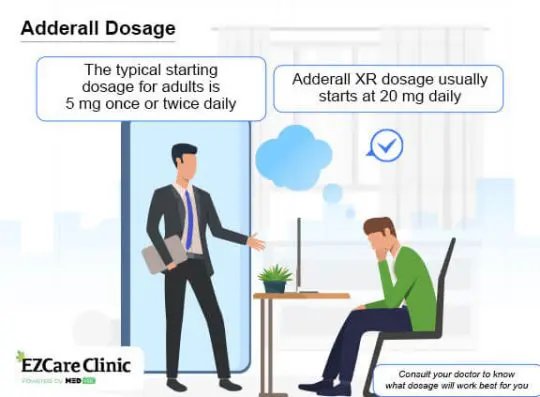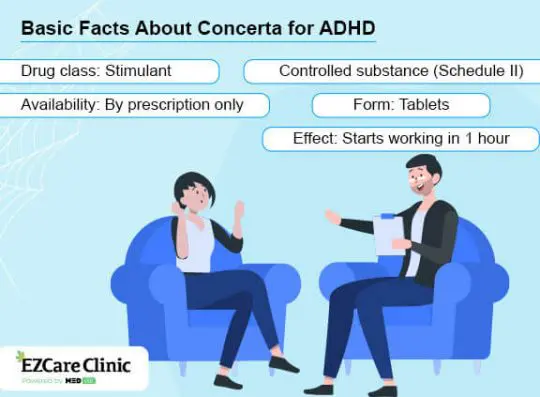The medications listed on this website are provided for informational purposes only. Their inclusion does not guarantee that they will be prescribed to any individual, as treatment decisions are ultimately at the discretion of healthcare providers. This list is not exhaustive, and healthcare providers may prescribe other medications, including non-stimulant options, based on the patient's unique health circumstances and needs.
Concerta and Adderall are stimulant medications for treating hyperactivity and impulsivity symptoms in individuals with attention-deficit hyperactivity disorder (ADHD). While the drugs are similar in multiple ways, including activating particular neurotransmitters in the brain to alleviate ADHD symptoms, Adderall differs from Concerta. Thus, ADHD patients or their caregivers need to understand the specifics of Concerta vs Adderall to ensure they use the medication correctly.
The choice of ADHD medications depends on a number of aspects. Get the most suitable medicine prescribed at EZCare Clinic.
Concerta vs Adderall
Adderall and Concerta are brand names of ADHD medications. While both are stimulants, Concerta contains methylphenidate as the active ingredient, with Adderall being a mixture of amphetamine salts. Adderall contains dextroamphetamine and levoamphetamine in a ratio of 3:1.
A quick review of Adderall vs Concerta highlights some differences between these ADD stimulant medications.
| Concerta | Adderall | |
| Drug class | Stimulant | Stimulant |
| Active ingredient(s) | Methylphenidate | Dextroamphetamine, Amphetamine |
| Drug form and release option available | Extended-release oral tablets | Immediate-release tablets, extended-release capsules |
| The typical duration of treatment | Long-term | Long-term |
| Dosage | 18 mg to 36 mg taken once by mouth daily. The daily dose should not exceed 72 mg | The initial Adderall dosage is 5 mg to 19 mg for immediate-release tablets (taken once or twice daily). It can be increased by 5 mg weekly until the desired outcome is achieved. The maximum daily dosage is 60 mg. The starting dose is 20 mg once daily for slow-release capsules. |
| The onset of action to peak | Peak action occurs 6-10 hours after ingestion | Peak effects in 3 hours for immediate-release formulation and in 7 hours for extended-release capsules |
| Potential for abuse | Yes, classified as a controlled substance (Schedule 2) | Yes, classified as a controlled substance (Schedule 2) |
Adderall vs Concerta: How They Work
ADHD symptoms are believed to stem from the deficiency of dopamine and norepinephrine neurotransmitters. As stimulant medications, Concerta and Adderall boost the level of these brain chemicals by blocking their reuptake. Enhanced neurotransmitter concentration increases neuron activity in particular brain areas, leading to increased focus, reduced impulsivity, and enhanced inhibition control for people with ADHD. Thus, the drugs help you cope better with ADHD.
That said, the onset of effects differs between the medications. If you take the immediate-release Adderall tablet, it usually takes 30 minutes to work and peak blood concentration occurs within 3 hours, and the effect starts to wear off. On the other hand, Concerta for ADHD begins to work within an hour, with the effect lasting about 6-10 hours. That’s why the immediate-release Adderall formulation is taken multiple times a day, while Concerta is only taken once daily.

Subjects struggling with narcolepsy, a sleep disorder characterized by excessive sleepiness during the day, can also take Adderall. The stimulants promote daytime wakefulness and alertness.
Generic Adderall vs Concerta Generic
Concerta generic is methylphenidate, while generic Adderall is amphetamine and dextroamphetamine. Similar to the brand versions in active ingredients, dosage strengths, and formulations, generic medications work the same way as brand drugs. The only difference is manufacturing companies and cost. Thus, you will pay relatively less for the Concerta or Adderall generic but obtain similar effects.
With EZCare, you can be sure about getting your prescription refilled in time.
Concerta vs Adderall: Side Effects
Due to similar mechanisms of action, Concerta and Adderall have many side effects in common.
- Loss of appetite
- Feeling of nervousness
- Headache
- Dry mouth
- Dizziness
- Irritability or agitation
- Sweating
- Nausea, vomiting, or stomach upset
- Anxiety
While most of the above side effects are mild and frequently occur, others are serious but rare. For instance:
- Fainting
- Chest pain
- Breathlessness
- Cold extremities that turn blue or white (peripheral vasculopathy)
- Increased aggression
- Auditory hallucinations
- Vision problems
- Prolonged erections in males
- Increased risk of stroke and heart attack
Potential for Abuse in Concerta vs Adderall
Both stimulant medications carry a significant potential for abuse which can lead to psychological and physical dependence. Thus, The U.S. Drug Enforcement Administration (DEA) classifies Adderall and Concerta as Schedule II controlled substances according to the Controlled Substances Act.
The amphetamine in Adderall promotes hippocampal functioning and contributes to addiction development and maintenance. Likewise, Concerta’s methylphenidate is habit-forming, increasing the likelihood of tolerance and dependence. Persons dependent on or tolerant to Adderall or Concerta often use higher doses than recommended, increasing the risk of serious side effects such as cardiac problems.

Conclusion
Adderall and Concerta are ADHD prescription medications with more similarities than differences. Both drugs have generics and treat ADHD in the same manner. If you have a prescription for either of the meds and you have concerns, contact your doctor for clarification.
Expert help for mental health issues.
Get treatment from licensed healthcare professionals.



